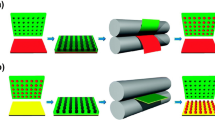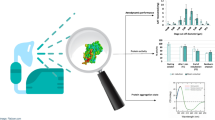Purpose
This study was conducted to assess the feasibility of a pulmonary formulation of tissue plasminogen activator (tPA) for nebulization into the airway by measuring protein stability, biologic activity, particle size, and estimating human lung distribution.
Methods
Formulations were derived by varying the surfactant and protein concentrations. Protein stability and recovery of each nebulized tPA formulation were assessed by ultraviolet spectroscopy. Formulations that met protein stability feasibility criteria were assessed for biologic and fibrinolytic activities. Biologic activity was determined by their ability to inhibit superoxide anion production by human neutrophils. Fibrinolytic activity was assessed by the cleavage of plasminogen to plasmin. Aerodynamic properties were assessed using a cascade impactor, and an estimation of human airway deposition was made via a human lung replica.
Results
Twenty-seven tPA formulations were initially assessed, 15 of which met protein stability criteria. Subsequently, three of these formulations maintained biologic and fibrinolytic activities. These formulations exhibited particle sizes of 2.4–3.1 μm, and had respirable doses ≥65%. A formulation of 1mg mL−1 tPA and 0.1% Tween 80 exhibited a 45% deposition in the lower airways of a human lung replica.
Conclusions
A suitable pulmonary tPA formulation was identified that, following nebulization, maintained protein stability as well as biologic and fibrinolytic activities, and resulted in an optimal respirable dose and human airway deposition. This formulation may be applicable in the treatment of lung diseases, such as acute respiratory distress syndrome by permitting targeted pulmonary delivery of a therapeutic protein to the lungs.






Similar content being viewed by others
References
K. A. Stringer (2000) ArticleTitleTissue plasminogen activator inhibit reactive oxygen species production by macrophages Pharmacotherapy 20 IssueID4 375–379 Occurrence Handle10.1592/phco.20.5.375.35059 Occurrence Handle10772365
K. A. Stringer J. Lindenfeld A. J. Repine Z. Cohen J. E. Repine (1997) ArticleTitleTissue plasminogen activator (tPA) inhibits human neutrophil superoxide anion production in vitro Inflammation 21 IssueID1 27–34 Occurrence Handle10.1023/A:1027334607606 Occurrence Handle9179619
C. A. Piantadosi D. A. Schwartz (2004) ArticleTitleThe acute respiratory distress syndrome Ann. Intern. Med. 141 460–470 Occurrence Handle15381520
C. Kane S. Galanes (2004) ArticleTitleAdult respiratory distress syndrome Crit. Care Nurs. Q. 27 IssueID4 325–335 Occurrence Handle15537121
K. F. Udobi E. Childs K. Touijer (2003) ArticleTitleAcute respiratory distress syndrome Am. Fam. Phys. 67 IssueID2 315–322
T. Yang F. Mustafa S. Bai F. Ahsan (2004) ArticleTitlePulmonary delivery of low molecular weight heparins Pharm. Res. 21 IssueID11 2009–2016 Occurrence Handle10.1023/B:PHAM.0000048191.69098.d6 Occurrence Handle15587922
M. M. G. Aguiar J. M. Rodrigues SuffixJr. A. S. Cunha (2004) ArticleTitleEncapsulation of insulin–cyclodextrin complex in PLGA microspheres: a new approach for prolonged pulmonary insulin delivery J. Microencapsul 21 IssueID5 553–564 Occurrence Handle10.1080/02652040400000447 Occurrence Handle15513761
N. R. Labiris M. B. Dolovich (2003) ArticleTitlePulmonary drug delivery. Part I: physiological factors affecting therapeutic effectiveness of aerosolized medications Br. J. Clin. Pharmacol. 56 588–599 Occurrence Handle10.1046/j.1365-2125.2003.01892.x Occurrence Handle14616418
N. R. Labiris M. B. Dolovich (2003) ArticleTitlePulmonary drug delivery. Part II: the role of inhalant delivery devices and drug formulations in therapeutic effectiveness of aerosolized medications Br. J. Clin. Pharmacol. 56 600–612 Occurrence Handle10.1046/j.1365-2125.2003.01893.x Occurrence Handle14616419
H. Mach J. A. Thomson C. R. Middaugh R. V. Lewis (1991) ArticleTitleExamination of phenylalanine microenvironments in proteins by second-derivative absorption spectroscopy Arch. Biochem. Biophys. 287 IssueID1 33–40 Occurrence Handle10.1016/0003-9861(91)90384-U Occurrence Handle1897992
H. Mach C. R. Middaugh (1994) ArticleTitleSimultaneous monitoring of the environment of tryptophan, tyrosine, and phenylalanine residues in proteins by near-ultraviolet second-derivative spectroscopy Anal. Biochem. 222 323–331 Occurrence Handle10.1006/abio.1994.1499 Occurrence Handle7864355
B. M. Dunn P. E. Scarborough R. Davenport W. Swietnicki (1994) ArticleTitleAnalysis of proteinase specificity by studies of peptide substrates. The use of UV and fluorescence spectroscopy to quantitate rates of enzymatic cleavage Methods Mol. Biol. 36 225–243 Occurrence Handle7697110
J. S. Dunn B. M. Freed D. L. Gustafson K. A. Stringer (2005) ArticleTitleInhibition of human neutrophil reactive oxygen species production and p67phox translocation by cigarette smoke extract Atherosclerosis 179 261–267 Occurrence Handle10.1016/j.atherosclerosis.2004.11.011 Occurrence Handle15777540
B. Gelder Particlevan E. C. Slater (1962) ArticleTitleThe extinction coefficient of cytochrome c Biochim. Biophys. Acta 58 593–595 Occurrence Handle10.1016/0006-3002(62)90073-2 Occurrence Handle13897582
D. L. Swift (1993) Aerosol characterization and generation F. Moren M. B. Dolovich M. T. Newhouse S. P. Newman (Eds) Aerosols in Medicine: Principles, Diagnosis and Therapy Elsevier Amsterdam 61–84
J. D. Brain J. D. Blanchard (1993) Mechanisms of particle deposition and clearance F. Moren M. B. Dolovich M. T. Newhouse S. P. Newman (Eds) Aerosols in Medicine: Principles, Diagnosis and Therapy Elsevier Amsterdam 124–135
Y. S. Cheng C. S. Fu D. Yazzie Y. Zhou (2001) ArticleTitleRespiratory deposition patterns of salbutamol pMDI with CFC and HFA-134a formulations in a human airway replica J. Aerosol Med. 14 IssueID2 255–266 Occurrence Handle10.1089/08942680152484180 Occurrence Handle11681657
Y. S. Cheng Y. Zhou B. Y. Chen (1999) ArticleTitleParticle deposition in a cast of human oral airways Aerosol Sci. Technol. 31 286–300 Occurrence Handle10.1080/027868299304165
K. D. Hoang P. Rosen (1992) ArticleTitleThe efficacy and safety of tissue plasminogen activator in acute ischemic strokes J. Emerg. Med. 10 IssueID3 345–352 Occurrence Handle10.1016/0736-4679(92)90341-P Occurrence Handle1624747
J. D. Rutherford E. Braunwald (1990) ArticleTitleThrombolytic therapy in acute myocardial infarction Chest 97 IssueID4 Suppl 136S–145S Occurrence Handle2108851
K. A. Stringer J. S. Dunn D. L. Gustafson (2004) ArticleTitleAdministration of exogenous tissue plasminogen activator reduces oedema in mice lacking the tissue plasminogen activator gene Clin. Exp. Pharmacol. Physiol. 31 IssueID5–6 327–330 Occurrence Handle10.1111/j.1440-1681.2004.03999.x Occurrence Handle15191406
W. J. Fulkerson N. MacIntyre J. Stamlet J. D. Crapo (1996) ArticleTitlePathogenesis and treatment of the adult respiratory distress syndrome Arch. Intern. Med. 156 29–38 Occurrence Handle10.1001/archinte.156.1.29 Occurrence Handle8526694
J. A. Cooper S. K. Lo A. B. Malik (1988) ArticleTitleFibrin is a determinant of neutrophil sequestration in the lung Circ. Res. 63 735–741 Occurrence Handle3168176
W. L. Lee G. P. Downey (2001) ArticleTitleNeutrophil activation and acute lung injury Curr. Opin. Crit. Care 7 1–7 Occurrence Handle10.1097/00075198-200102000-00001 Occurrence Handle11373504
A. M. Munster E. Bendstrup J. I. Jensen J. Gram (2000) ArticleTitleJet and ultrasonic nebulization of single chain urokinase plasminogen activator (scu-PA) J. Aerosol Med. 13 IssueID4 325–333 Occurrence Handle11262439
P. Enkhbaatar K. Murakami R. Cox M. Westphal N. Morita K. Brantley A. Burke H. Hawkins F. Schmalstieg L. Traber D. Herndon D. Traber (2004) ArticleTitleAerosolized tissue plasminogen inhibitor improves pulmonary function in sheep with burn and smoke inhalation Shock 22 IssueID1 70–75 Occurrence Handle10.1097/01.shk.0000129201.38588.85 Occurrence Handle15201705
D. C. Cipolla I. Gonda S. Shak I. Kovesdi R. Crystal T. D. Sweeney (2000) ArticleTitleCoarse spray delivery to a localized region of the pulmonary airways for gene therapy Hum. Gene Ther. 11 361–371 Occurrence Handle10.1089/10430340050016085 Occurrence Handle10680848
M. B. Dolovich R. C. Ahrens D. R. Hess P. Anderson R. Dhand J. L. Rau G. C. Smaldone G. Guyatt (2005) ArticleTitleDevice selection and outcomes of aerosol therapy: evidence-based guidelines Chest 127 IssueID1 335–371 Occurrence Handle10.1378/chest.127.1.335 Occurrence Handle15654001
W. T. Cefalu (2004) ArticleTitleEvolving strategies for insulin delivery and therapy Drugs 64 IssueID11 1149–1161 Occurrence Handle15161324
J. L. Rau (2005) ArticleTitleThe inhalation of drugs: advantages and problems Respir. Care 50 IssueID3 367–382 Occurrence Handle15737247
S. Idell (2001) ArticleTitleAnticoagulants for acute respiratory distress syndrome: can they work? Am. J. Respir. Crit. Care Med. 164 517–520 Occurrence Handle11520709
S. Idell K. B. Koenig D. S. Fiar T. R. Martin J. McLarty R. J. Maunder (1991) ArticleTitleSerial abnormalities of fibrin turnover in evolving adult respiratory distress syndrome Am. J. Physiol. 261 L240–L248 Occurrence Handle1928357
Acknowledgment
This work was funded by a National Institutes of Health Grant R41 HL071439-01A1.
Author information
Authors and Affiliations
Corresponding author
Rights and permissions
About this article
Cite this article
Dunn, J.S., Nayar, R., Campos, J. et al. Feasibility of Tissue Plasminogen Activator Formulated for Pulmonary Delivery. Pharm Res 22, 1700–1707 (2005). https://doi.org/10.1007/s11095-005-6335-8
Received:
Accepted:
Published:
Issue Date:
DOI: https://doi.org/10.1007/s11095-005-6335-8




